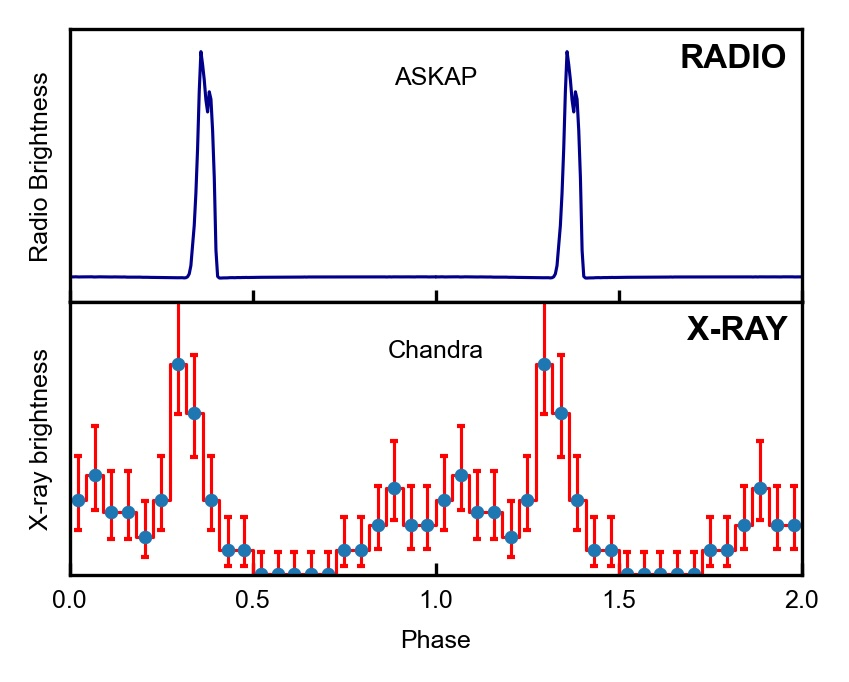For the first time, a long-period radio transient Source (LPRT) has also been spotted by an X-ray telescope. That means we now have observations of this object from both ends of the electromagnetic spectrum, but not at the wavelengths in between. Despite the sources of two LPRTs recently being identified, the team that found the new example remain cautious about the type of object that could be producing signals like this.
ASKAP J1832-0911 was found by astronomers using the Australian Square Kilometer Array Pathfinder radio telescope. It produces an extremely powerful burst of radio waves for two minutes every 44 minutes. Just how powerful has varied over the 10 months for which we have data. At its peak, however, Dr Ziteng (Andy) Wang of the Curtin University node of the International Center for Radio Astronomy Research told IFLScience that ASKAP J1832-0911 would be one of the 30 brightest radio sources in the sky. Moreover, the Chandra X-ray Observatory has detected X-rays from the same location with the same cycle.
“Discovering that ASKAP J1832-0911 was emitting X-rays felt like finding a needle in a haystack,” Wang said in a statement. “The ASKAP radio telescope has a wide field view of the night sky, while Chandra observes only a fraction of it. So, it was fortunate that Chandra observed the same area of the night sky at the same time.”

The match in timing of the radio and X-ray peaks leaves little doubt that the source is the same, despite some imprecision in identifying the location.
Image credit: Ziteng (Andy) Wang, ICRAR
So far, however, we have not been able to find the source of these radio and X-rays at wavelengths in between. That’s not as surprising as it may sound. Wang explained to IFLScience that ASKAP J1832-0911 lies in a very crowded part of the galaxy from our perspective. It’s also thought to be about 15,000 light years away. That not only means there are plenty of objects that could be obscuring it, but an immense amount of dust blocks our line of sight, so the source would need to be very bright at optical wavelengths to be visible. Infrared searches have also yielded nothing, despite being less affected by dust, but the JWST is yet to take a look.
In the last few years, advances in radio telescope technology have allowed astronomers to discover several classes of objects we had no idea existed, and still can’t fully explain. LPRTs are one of these. They emit bursts of radio waves on a cycle of many minutes or hours, much longer than any experimentally observed pulsars, and also longer than should theoretically be possible for pulsars. ASKAP J1832-0911 is the tenth found so far, but the first where X-rays have been detected as well, despite efforts in other cases.
Many of the LPRTs appear to switch on and off, the signal often having vanished when telescopes return to the site for a second look. ASKAP J1832-0911 instead has got brighter and dimmer over time, but remained on cycle.
LPRTs’ emission spectra are too broad to be the products of extraterrestrial civilizations. Last year, a breakthrough came with the finding that one LPRT is almost certainly coming from a system where red and white dwarf stars are locked in a tight orbit, and since then, an even clearer example has been found.
Even when the first such example was discovered, however, Dr Natasha Hurley-Walker, who lead the discovery, expressed doubts about whether all LPRTs had a common cause.
Wang told IFLScience that for ASKAP J1832-0911 to also be the product of a red and white dwarf pairing would require the most magnetized white dwarf we have found. The required magnetic field of more than 5 x 109 Gauss would not be far outside the range of current observations, but Wang still considers an old magnetar more likely.

Artist’s impression of a magnetar, one of the two main contenders for the source of the emissions.
Image credit: ICRAR
Magnetars are neutron stars with magnetic fields far more powerful than those of any white dwarf yet found, so the field strength is not a problem, but there are reasons to question whether a magnetar alone could be responsible. Wang described the possibility of a magnetar orbited by a main sequence star once every 164 minutes as “plausible”, adding that the team had not performed exhaustive modeling of the possibilities.
Meanwhile, co-author Professor Nanda Rea of the Spanish Institute of Space Science said in a statement, “Finding one such object hints at the existence of many more.”
The study is published in Nature.
Source Link: Newly Discovered Repeating Radio Source Is First To Be Seen In X-Rays Too